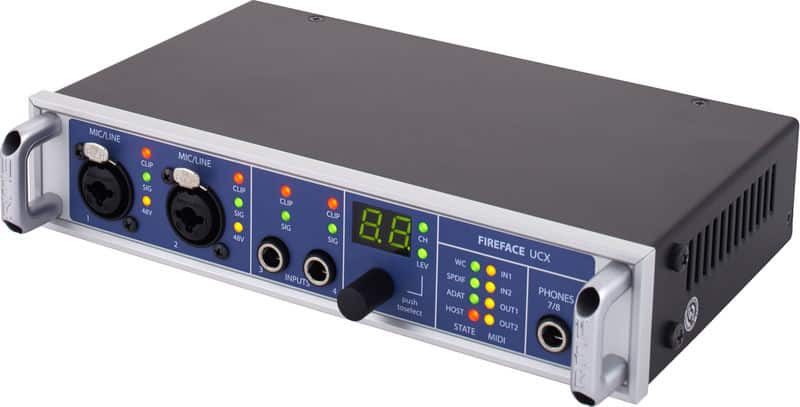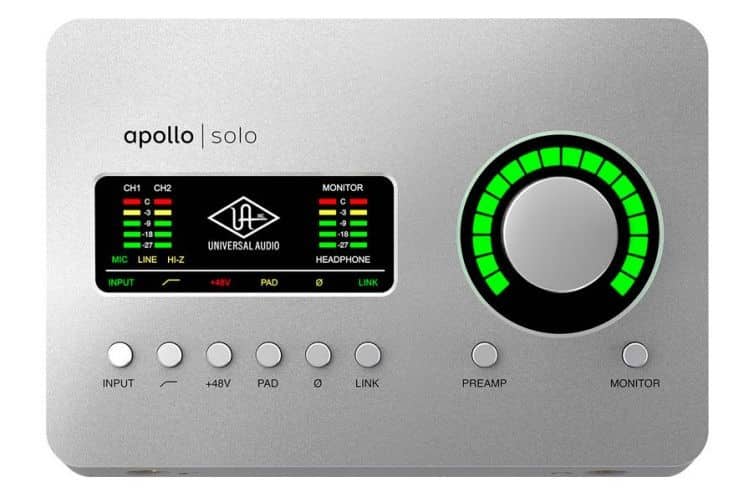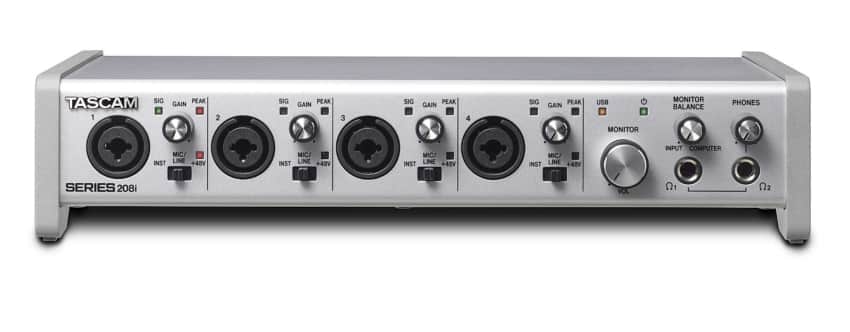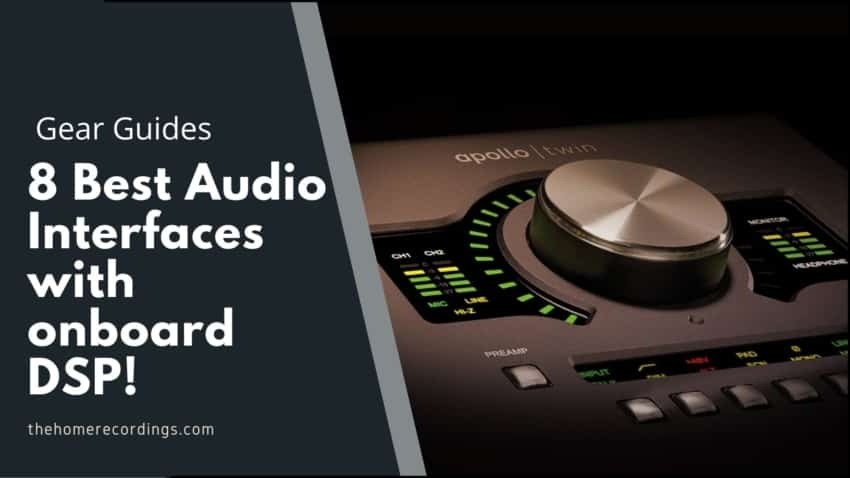Last updated on December 30th, 2023 at 02:45 pm
In this article, I will be covering some of the best audio interfaces that come with onboard DSP, both usable while recording or monitoring, plus I will be going over their Inputs and outputs, included software and overall features.
Now, if you don’t have a clear understanding of what DSP means and how it works, here’s a quick explanation:
What is DSP?
DSP or digital signal processing is the mathematic molding of your signals by a microprocessor inside your audio hardware’s circuitry. This molding results in the formation of commonly known effects such as equalization, compression, and delay, and all of this is processed directly by the interface and not the computer, taking the load off your CPU.
Once sound has been converted into binary through an analog to digital converter it can be manipulated and enhanced in a variety of ways by this microprocessor. Signals can then be volleyed from a digital to analog converter, to a speaker, and subsequently to your eardrums. You can think of digital signal processing as being the secret sauce of A/D D/A.
DSP is becoming as common in modern audio equipment as seeing a foot in a shoe. It can be found in everything: from your AirPods to the most savage salary slicing studio monitors you could only dream about.
Benefits an Audio Interface with Onboard DSP Processing?
An audio interface with onboard digital signal processing essentially lets you use built-in effects pre-DAW.
Something you may find appealing about this is the load it takes off your computer’s CPU. Let’s say for instance, your shoestring budget laptop’s DAW has an FX chain longer than The Great Wall of China going on, these effects will consume all of your CPU’s processing power! Using the interface’s built-in FX relives your computer of this strain.
DSP also helps to resolve latency issues which arise from using native plugins during tracking sessions. Perhaps you have a vocalist who requires an oceanic amount of reverb for them to get in their groove, but when sending the signal through the computer to add reverb, you’re not just straining the CPU but there’s also a lot of latency being introduced.
Your interface’s DSP reverb will allow you to provide the singer with as much of the effect as they desire, but without any latency.
Some Audio Interfaces can even run an entire amp simulation, which makes recording electric guitar without any latency a breeze.
Ok now, let’s get straight into the list!
1. Apollo Twin MKII

Universal Audio’s Apollo Twin MKII is a compact and powerful desktop Thunderbolt/USB interface which has been celebrated by names such as Fab Dupont (Andre 3000, Snarky Puppy) and Andrew Dawson (Jay-Z, Kanye West).
The Apollo Twin contains two line/mic preamps, an instrument input, a headphone output, and 2 monitor outputs. It also offers the ability to add 8 channels of audio through its optical digital input.
Apollo Twin comes with a delightful dollop of DSP, featuring emulations of a vintage UA 610-B preamp, LA-2A and 1176LN compressors, Pultec EQ, Marshall Plexi guitar amplifier, Ampeg SVT bass amp, and a Pro Co Rat distortion pedal.
It also features a handful of modern effects in its Precision Mix Rack collection and RealVerb Pro reverb. All these effects can be printed with your signals into your DAW or used exclusively for monitoring purposes.
Universal Audio also has a ton of other effects available which will cost you extra but are certainly worth every cent.
There are three types of Apollo Twin MKII on the market today: Solo, Duo and Quad. Their names have to do with the number of processors in their circuitry, more processors = more DSP plug-ins capable of being ran in an instance.
Depending on the interface and implying you negate a bundle deal, you can expect to pay about $800 for a Duo or $1400 for a Quad.
Find out more about the Apollo Twin MKII here:
- Apollo Twin MKII: Amazon, Sweetwater.
2. Steinberg UR44C

Steinberg’s UR44C USB interface was designed with travelling music makers in mind. Renowned Yamaha coherence is offered up in a rugged and road worthy portable enclosure.
UR44C features 4 Yamaha D-PRE mic/line level preamps on the front panel, 2 of which may be switched to HI-Z instrument inputs, along with 2 additional line level inputs on the back panel. 6 analog outputs, 2 independently adjustable headphone outputs, and MIDI I/O compatibility are all made available.
UR44C uses a Yamaha SSP3 chip for its DSP, with their dspMixFx app offering control over it. A channel strip with EQ and compression, REV-X hall/plate/room reverb, plus clean, crunch, drive, and lead guitar amplifier emulations are included.
All these effects, bar one, can be used for either tracking or exclusively monitoring. Its reverb effect can only be used for monitoring, you will have to use the plugin version of the effect in your DAW if you would like it to be included in your recording.
Find out more about the Steinberg’s UR44C here:
- Steinberg’s UR44C: Amazon, Sweetwater.
3. Audient Sono

Audient Sono is a USB interface designed specifically for guitarists; this is not your average amp modeler by any means though. It offers everything you need to brew the most beautiful tones that would make even the sternest six-stringed savant shed a tear.
Sono features 2 mic/line preamps, one of which can be switched to a high voltage 12AX7 valve. A guitar input, 8 track ADAT input, a re-amp output, and a headphone output are also included. A great feature of Sono is its 3-band analog EQ which helps you shape your sounds before they delve into digitality.
Sono uses Two Note’s Torpedo DSP to provide you with emulations of cabinets, placement adjustable dynamic, condenser and ribbon microphones, plus a wide variety of unique rooms and effects. 3 pre-sets of these combinations can be saved directly to Sono, so your tone is ready to go without ever turning on a PC. These sounds can be recorded wet into your DAW, with the option of using your clean DI signal also available.
Find out more about the Audient Sono here.
- Audient Sono: Amazon, Sweetwater.
4. Fireface UCX

RME released Fireface UCX back in 2012, due to it being such an ergonomically condensed interface with top notch converters and latency liquidating DSP, it has found its way into the travel bag of many artists and engineers who are on the road more than Willie Nelson.
Fireface UCX is a FireWire/USB interface which contains 2 mic/instrument/line, 2 instrument/line, and 4 line-level inputs. It also features 6 line-level outputs and a headphone output. S/PDIF, ADAT, and MIDI I/O, as well as a word clock syncing feature are all included.
The FIreface UCX comes with a software named DigiCheck, which is a metering, measurement, and analytic tool for your audio.
One of the best things RME have included with UCX is its ARC USB remote control, which lets you operate its Total Mix app without monotonous mouse clicking, giving you control over a 3-band EQ with a low-cut filter, and a dynamics module containing a compressor, expander, and auto leveler.
2 send effects are also available: a reverb which includes algorithms of rooms, space, vintage reverb, and many more, as well as an echo effect which includes settings of stereo echo, stereo cross, and pong echo.
The insert effects can be recorded into your DAW with the simple click of a button; but for the send effects, you must use its loopback feature and a touch of routing rigmarole.
Find out more about the Fireface UCX here.
- Fireface UCX: Sweetwater.
5. Apollo Solo

Next up we have Universal Audio’s Apollo Solo, which has been cheered on by big names such as Terry Lewis (Prince, Janet Jackson) and Rik Simpson (Jay-Z, Portishead). Don’t think of this as just Twin’s bashful little brother, it’s perfect for people who need renowned UA converters and care not for Twins bells and whistles. And most importantly remember, Apollo Solo’s feature trimming saves you unnecessary wallet trimming.
The Solo’s analog inputs are 2 combo jack mic/line-level inputs and a HI-Z instrument input. 2 monitor outputs and a headphone output are also included.
Where Solo differs from the Twin is that it is lacking in 2 line-level outputs, contains no optical input, and only features one microprocessor: leading to less overall DSP capabilities.
Apollo Solo uses UA’s Unison Technology to mold your preamp’s sound into emulations of classics, such as the UA 610-B. The Solo also comes with emulations of a Marshall guitar amp, Ampeg bass amp, Pultec EQ, Teletronix LA-2A levelling amplifier, 1176LN limiter, and a Pro Co Rat distortion stomp box.
A modern channel strip, 2 delays, and a reflection engine, as well their RealVerb Pro reverb plug-in are also included. All these DSP effects can be used exclusively for monitoring or recorded directly into your DAW.
Find out more about the Apollo Solo here.
- Apollo Solo: Amazon, Sweetwater.
6. TASCAM US-16×08

Audio titans Tascam released a fantastic USB interface back in 2014, the US-16×08. It would suit a project studio producer perfectly, offering inputs aplenty and a dignified dash of digital signal processing.
On the front panel of the US-16×08 you will find 8 XLR inputs with Tascam Ultra-HDDA preamplifiers. It also offers 2 line/instrument level inputs, along with 3 stereo pairs of line level inputs which can be optimized for pro and consumer equipment by a -10dBV/+4dBu switch.
The US-16×08 also has 6 line-level outputs, 2 monitor outputs, a headphone output, and MIDI I/O. The standout hardware feature TASCAM includes is the ability to use the US-16×08 exclusively for its preamplifiers, without ever having to utilize its USB connection.
The US-16×08 comes with included software which gives you control over its DSP. 2 effects have been given: a 4-band EQ with a low-cut filter, and a compressor.
Both effects contain graphing visuals, so your ears aren’t doing it alone. You can stereo link tracks for simultaneous processing, as well as copy and paste for creating group effect scenarios. A big setback about the US-16×08’s DSP is that you cannot use its effects exclusively for monitoring purposes, they are either not activated or they will be recorded into your DAW.
Find out more about the TASCAM US-16×08 here.
- TASCAM US-16×08: Amazon, Sweetwater.
7. MOTU UltraLite-mk5

MOTU have a brand spanking new interface that would suit a travelling singer-songwriter or DJ down to the ground. UltraLite-mk5 lives up to its name, it’s an extremely compact piece of hardware which would fit in a gig bag like a pea in a pod.
UltraLite-mk5 features 2 mic/line/instrument combo jacks and 6 line-level inputs. Also included are two monitor outputs, a headphone output, and 8 line-level outputs. MIDI, S/PDIF, plus optical inputs and outputs are also in reach. UltraLite-mk5 features a metering display on the front panel, giving you a clear image of all your input and output levels.
MOTU’s Performer Lite has also been included as well as 6GB of loops and samples.
MOTU’s DSP is controlled through their Cue Mix 5 app. You are granted control over a 4-band EQ for each individual track, a 3-band EQ for the master, a compressor, a reverb, and a gate effect. You can switch between pre-FX for monitoring only or post-FX for the processed signal to be recorded into your DAW.
The standout feature from UltraLite-mk5 is the ability to use these effects without connecting the interface to a computer: essentially turning itself into a miniature digital mixer.
Find out more about the MOTU UltraLite-mk5 here.
- MOTU UltraLite-mk5: Sweetwater.
8. TASCAM Series 208i

To round off this list I have another midrange priced USB interface from TASCAM, the Series 208i. Don’t let how snuggly it fits on a desktop fool you; this interface packs a ton of I/0 capability into a primp and proper parcel.
The Series 208i gives you 4 XLR/TRS mic/line/instrument-level inputs with the ability to select phantom power for each individual input, your ribbons and condensers can peacefully coexist! 2 monitor outputs, 6 line-level outputs, and 2 headphone outputs have also been made available to you.
There is also MIDI and word clock I/O, as well as a 16 track S/MUX optical input. The Series 208i also includes a monitor balance pot, which allows you to blend your dry direct monitoring signal and your wet DAW signal.
Series 208i comes with included software which gives you control over some fantastic onboard DSP: A compressor, 4-band EQ with a low-cut filter, phase inverter, and reverb are all on offer to process your signal before it jumps into your DAW.
The downside to this interface is the fact that when these effects are enabled it is obligatory that they are recorded into your DAW, not ideal for those who just use FX to gain momentum while monitoring.
Find out more about the TASCAM Series 208i here.
- TASCAM Series 208i: Amazon, Sweetwater.
Conclusion
Some of these interfaces cost well above $1500 and I honestly think that spending that much isn’t necessary for most people.
In general, I’d recommend to either go with the Steinberg UR44C or the Apollo Twin MKII, unless you’re a guitarist who mainly want to record guitar and have some onboard cab simulation, in which case I’d recommend the Sono.
I Hope this information was useful!
Have a great day!
